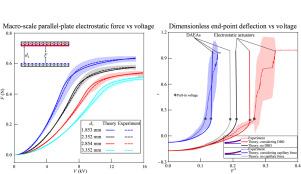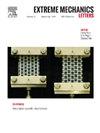Pull-in instability of droplet amplified electrostatic actuators considering dielectric barrier discharge
IF 4.5
3区 工程技术
Q2 MATERIALS SCIENCE, MULTIDISCIPLINARY
引用次数: 0
Abstract
Liquid-amplified electrostatic actuators can generate greater forces than conventional ones which use air as the dielectric between two electrodes. Dielectric droplet amplified electrostatic actuators, a major type of liquid amplified electrostatic actuator, can be used to provide powerful, fast, energy-efficient, and lightweight actuations. However, the mechanical response of droplet amplified electrostatic actuator and the liquid amplification mechanism remain unexplored in a comprehensive way. Here we present a quasi-static model for droplet amplified electrostatic actuators considering dielectric barrier discharge and capillary force. The Galerkin method and the Newton method were used to numerically solve the model. A customized pull-in voltage measurement setup was established to verify the numerical results and the main influencing parameters were studied. The experimentally validated model can be used to accurately predict the quasi-static response and pull-in voltage of droplet amplified electrostatic actuators. This work highlights that the liquid amplification comes mainly from higher permittivity than air, dielectric barrier discharge elimination, and capillary force, due to the use of liquid dielectrics instead of air. The results in this work may provide useful insights into droplet amplified electrostatic actuator structural optimization, control, and application.

考虑介质阻挡放电的液滴放大静电致动器的拉入不稳定性
液体放大静电致动器比传统的使用空气作为两个电极之间的电介质的致动器产生更大的力。介质液滴放大式静电执行器是液体放大式静电执行器的主要类型,可以提供强大、快速、节能、轻便的执行器。然而,液滴放大静电执行器的力学响应和液体放大机理尚未得到全面的探讨。本文建立了考虑介质阻挡放电和毛细力的液滴放大静电致动器的准静态模型。采用伽辽金法和牛顿法对模型进行了数值求解。建立了自定义的拉入电压测量装置,对数值结果进行了验证,并对主要影响参数进行了研究。实验验证的模型可以准确预测液滴放大静电致动器的准静态响应和拉入电压。这项工作强调了液体放大主要来自于比空气更高的介电常数,介质阻挡放电消除和毛细力,由于使用液体介质而不是空气。研究结果为液滴放大静电致动器的结构优化、控制和应用提供了有益的启示。
本文章由计算机程序翻译,如有差异,请以英文原文为准。
求助全文
约1分钟内获得全文
求助全文
来源期刊

Extreme Mechanics Letters
Engineering-Mechanics of Materials
CiteScore
9.20
自引率
4.30%
发文量
179
审稿时长
45 days
期刊介绍:
Extreme Mechanics Letters (EML) enables rapid communication of research that highlights the role of mechanics in multi-disciplinary areas across materials science, physics, chemistry, biology, medicine and engineering. Emphasis is on the impact, depth and originality of new concepts, methods and observations at the forefront of applied sciences.
 求助内容:
求助内容: 应助结果提醒方式:
应助结果提醒方式:


